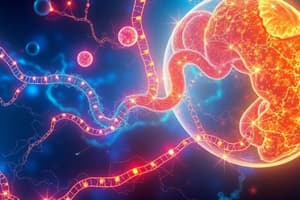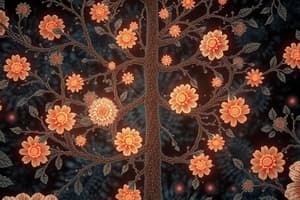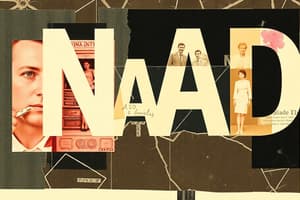Podcast
Questions and Answers
What role does NAD play during cellular respiration?
What role does NAD play during cellular respiration?
- It acts as an oxygen carrier to the electron transport chain.
- It produces glucose from CO2 and H2O.
- It breaks down glucose into CO2 and H2O.
- It transfers electrons between chemical reactions. (correct)
In the process of converting NAD to NADH, which of the following occurs?
In the process of converting NAD to NADH, which of the following occurs?
- NADH donates electrons directly to glucose.
- NAD loses electrons from substrates.
- NAD accepts electrons and hydrogen from substrates. (correct)
- NAD is synthesized from ATP.
Which statement accurately describes the relationship between glucose and ATP in glycolysis?
Which statement accurately describes the relationship between glucose and ATP in glycolysis?
- Glycolysis breaks down glucose into carbon dioxide and water.
- Glycolysis converts glucose to pyruvate while consuming ATP.
- Glycolysis converts glucose to pyruvate while producing NADH and ATP. (correct)
- Glycolysis synthesizes glucose from pyruvate using ATP.
What is the main purpose of the electron transport chain in aerobic respiration?
What is the main purpose of the electron transport chain in aerobic respiration?
Which of the following statements about redox reactions is correct?
Which of the following statements about redox reactions is correct?
What is the primary function of the electron transport chain in mitochondrial respiration?
What is the primary function of the electron transport chain in mitochondrial respiration?
Which molecule acts as the final electron acceptor in the electron transport chain?
Which molecule acts as the final electron acceptor in the electron transport chain?
In the process of chemiosmosis, how many hydrogen ions are required to convert ADP to ATP?
In the process of chemiosmosis, how many hydrogen ions are required to convert ADP to ATP?
Which statement accurately describes the role of NADH in the electron transport chain?
Which statement accurately describes the role of NADH in the electron transport chain?
What is the consequence of protons being unable to pass through the mitochondrial membranes?
What is the consequence of protons being unable to pass through the mitochondrial membranes?
Which of the following statements correctly describes the role of NAD in glycolysis?
Which of the following statements correctly describes the role of NAD in glycolysis?
In the context of glycolysis, which statement accurately reflects the relationship between ATP and ADP?
In the context of glycolysis, which statement accurately reflects the relationship between ATP and ADP?
Among the following, which statement accurately describes the crucial role of anaerobic respiration in glycolysis?
Among the following, which statement accurately describes the crucial role of anaerobic respiration in glycolysis?
If the oxidation step in glycolysis is disrupted, what is the most likely consequence?
If the oxidation step in glycolysis is disrupted, what is the most likely consequence?
What is the main role of the link reaction in cellular respiration?
What is the main role of the link reaction in cellular respiration?
A scientist is studying a new drug that inhibits the enzyme responsible for phosphorylating ADP to ATP in the glycolytic pathway. What is the expected outcome of this drug's action on glycolysis?
A scientist is studying a new drug that inhibits the enzyme responsible for phosphorylating ADP to ATP in the glycolytic pathway. What is the expected outcome of this drug's action on glycolysis?
Which of the following accurately describes the process of decarboxylation in the link reaction?
Which of the following accurately describes the process of decarboxylation in the link reaction?
What is the significance of oxaloacetate in the Krebs cycle?
What is the significance of oxaloacetate in the Krebs cycle?
What products are generated by one cycle of the Krebs cycle?
What products are generated by one cycle of the Krebs cycle?
How do lipids enter the metabolic pathway connected to the Krebs cycle?
How do lipids enter the metabolic pathway connected to the Krebs cycle?
What is the primary purpose of glycolysis in cellular respiration?
What is the primary purpose of glycolysis in cellular respiration?
Which statement accurately describes the role of NAD in cellular respiration?
Which statement accurately describes the role of NAD in cellular respiration?
What are the products of glycolysis per molecule of glucose?
What are the products of glycolysis per molecule of glucose?
During which phase of glycolysis are the 3-carbon sugars oxidized and electrons are transferred to NAD?
During which phase of glycolysis are the 3-carbon sugars oxidized and electrons are transferred to NAD?
What happens to the charges across the membrane during the process of chemiosmosis?
What happens to the charges across the membrane during the process of chemiosmosis?
What is the primary difference in the yield of ATP between aerobic and anaerobic respiration?
What is the primary difference in the yield of ATP between aerobic and anaerobic respiration?
In which location does aerobic respiration predominantly occur within the cell?
In which location does aerobic respiration predominantly occur within the cell?
Which of the following waste products is produced by anaerobic respiration?
Which of the following waste products is produced by anaerobic respiration?
Which factor is NOT mentioned as affecting the rate of respiration?
Which factor is NOT mentioned as affecting the rate of respiration?
What is the word equation for aerobic respiration?
What is the word equation for aerobic respiration?
What happens to ATP when it is hydrolyzed?
What happens to ATP when it is hydrolyzed?
Which statement accurately describes the role of ATP in cellular processes?
Which statement accurately describes the role of ATP in cellular processes?
In aerobic respiration, what are the end products of glucose breakdown?
In aerobic respiration, what are the end products of glucose breakdown?
What distinguishes anaerobic respiration from aerobic respiration?
What distinguishes anaerobic respiration from aerobic respiration?
During the process of gas exchange in human tissues, how do oxygen and carbon dioxide move?
During the process of gas exchange in human tissues, how do oxygen and carbon dioxide move?
Flashcards
What is NAD?
What is NAD?
NAD is a molecule that carries electrons from one reaction to another, especially during cellular respiration. It's like a tiny mail carrier, delivering electrons to the electron transport chain where energy is released.
What is NADH?
What is NADH?
NADH is the reduced form of NAD. It gains electrons and hydrogen, becoming 'full' like a grocery cart after a shopping trip. This is a key step in energy production.
What is a Redox Reaction?
What is a Redox Reaction?
It's a chemical reaction where one molecule loses electrons (oxidation) and another gains electrons (reduction). NAD plays a key role in this, transporting electrons like a shuttle.
What happens to NAD during glycolysis?
What happens to NAD during glycolysis?
Signup and view all the flashcards
What is the Electron Transport Chain?
What is the Electron Transport Chain?
Signup and view all the flashcards
Phosphorylation in Glycolysis
Phosphorylation in Glycolysis
Signup and view all the flashcards
Lysis in Glycolysis
Lysis in Glycolysis
Signup and view all the flashcards
Oxidation in Glycolysis
Oxidation in Glycolysis
Signup and view all the flashcards
ATP Formation in Glycolysis
ATP Formation in Glycolysis
Signup and view all the flashcards
Anaerobic Respiration
Anaerobic Respiration
Signup and view all the flashcards
What is glycolysis?
What is glycolysis?
Signup and view all the flashcards
What is chemiosmosis?
What is chemiosmosis?
Signup and view all the flashcards
Role of NAD in cellular respiration
Role of NAD in cellular respiration
Signup and view all the flashcards
What is the electron transport chain (ETC)?
What is the electron transport chain (ETC)?
Signup and view all the flashcards
What are the products of glycolysis?
What are the products of glycolysis?
Signup and view all the flashcards
What is the role of the link reaction in cellular respiration?
What is the role of the link reaction in cellular respiration?
Signup and view all the flashcards
What happens to pyruvate during the link reaction?
What happens to pyruvate during the link reaction?
Signup and view all the flashcards
Where does the Electron Transport Chain occur?
Where does the Electron Transport Chain occur?
Signup and view all the flashcards
What is Acetyl-CoA and how is it formed?
What is Acetyl-CoA and how is it formed?
Signup and view all the flashcards
Describe the Krebs Cycle.
Describe the Krebs Cycle.
Signup and view all the flashcards
What role does the proton gradient play in the electron transport chain?
What role does the proton gradient play in the electron transport chain?
Signup and view all the flashcards
What is the role of oxygen in the Electron Transport Chain?
What is the role of oxygen in the Electron Transport Chain?
Signup and view all the flashcards
What is the role of oxaloacetate in the Krebs cycle?
What is the role of oxaloacetate in the Krebs cycle?
Signup and view all the flashcards
Measuring Respiration Rate
Measuring Respiration Rate
Signup and view all the flashcards
Temperature and Respiration Rate
Temperature and Respiration Rate
Signup and view all the flashcards
Mass and Respiration Rate
Mass and Respiration Rate
Signup and view all the flashcards
What is ATP?
What is ATP?
Signup and view all the flashcards
What is cell respiration?
What is cell respiration?
Signup and view all the flashcards
What is aerobic respiration?
What is aerobic respiration?
Signup and view all the flashcards
What is anaerobic respiration?
What is anaerobic respiration?
Signup and view all the flashcards
How does ATP power active transport?
How does ATP power active transport?
Signup and view all the flashcards
Study Notes
Cellular Respiration
- Photosynthesis and cellular respiration are opposite processes
- Cellular respiration takes glucose and oxygen to create carbon dioxide, water and ATP
- Photosynthesis takes carbon dioxide and water to create glucose and oxygen, using light energy
- Cells use glucose as fuel for energy
Glycolysis
- Glycolysis has 10 steps
- Glycolysis begins with glucose and ends with pyruvate
- Glycolysis produces 2 ATP molecules and 2 NADH molecules
- Glycolysis occurs in the cytoplasm (cytosol)
- Two ATP are invested in glucose at the beginning
Link Reaction (Pyruvate Oxidation)
- Pyruvate is converted into acetyl CoA
- Pyruvate loses one carbon as CO2
- Pyruvate is oxidized, meaning it loses electrons
- NAD+ is reduced to NADH
- Acetyl CoA is the input into the Krebs cycle
Krebs Cycle (Citric Acid Cycle)
- The Krebs cycle is also known as the citric acid cycle
- Two carbons from Acetyl CoA enter the cycle
- The cycle turns twice per glucose molecule
- The cycle produces 2 ATP, 6 NADH, and 2 FADH2
Electron Transport Chain
- NADH and FADH2 carry electrons to the electron transport chain
- Electrons are passed along a chain of proteins
- Energy from the electron transfer is used to pump protons into the intermembrane space
- The protons flow back through ATP synthase, producing ATP
- Oxygen is the final electron acceptor
- 34 ATP are produced in the electron transport chain
- Water is a product of the electron transport chain
Anaerobic Respiration (Fermentation)
- Occurs with no oxygen
- Involves glycolysis, but no Krebs cycle or electron transport chain
- Two common types: lactic acid fermentation and alcoholic fermentation
- Lactic acid is a byproduct in muscle cells, and alcohol is the product of yeast fermentation
- 2 ATP are produced in fermentation
- NAD+ is regenerated
Studying That Suits You
Use AI to generate personalized quizzes and flashcards to suit your learning preferences.



